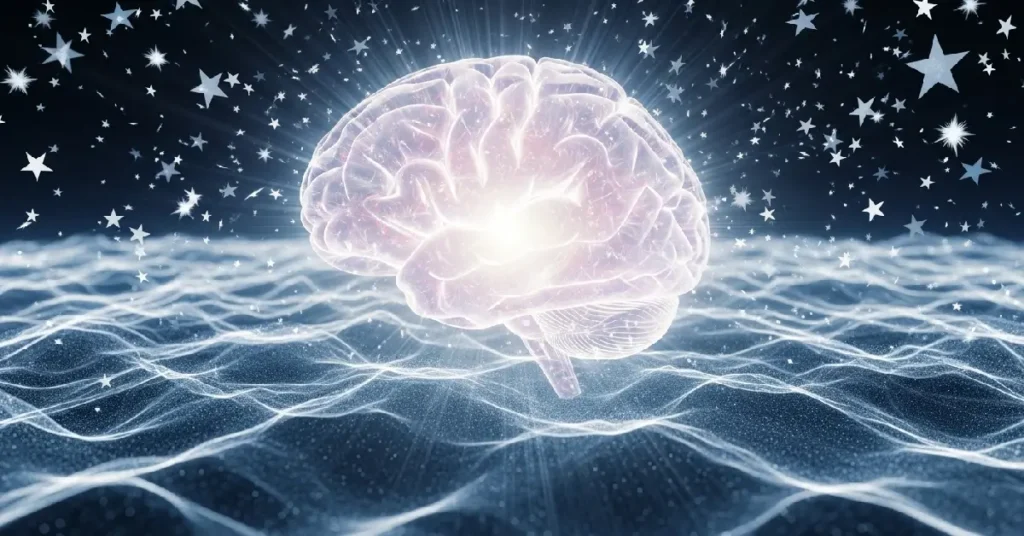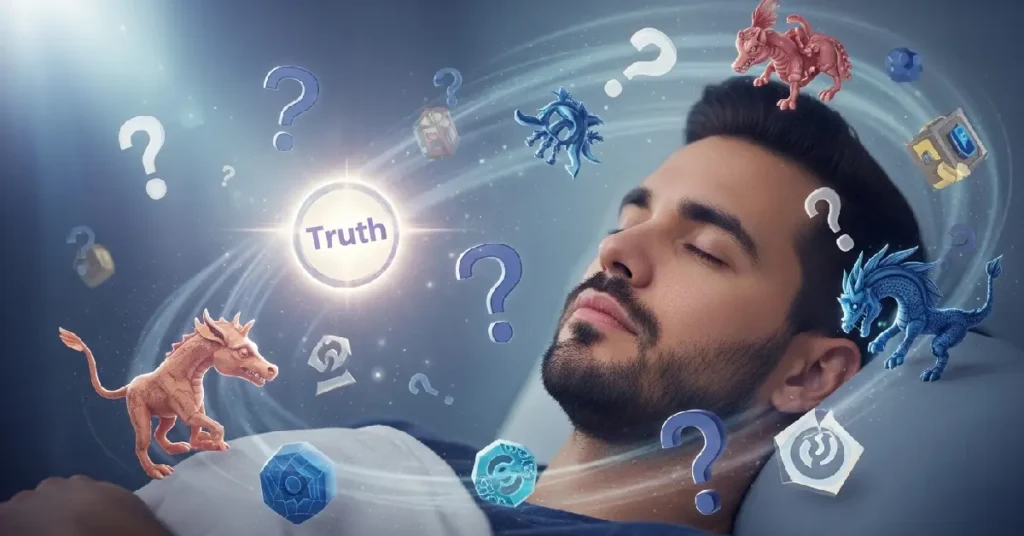Imagine you’re flying over a rainbow-colored ocean, laughing as dolphins leap beside you. Suddenly, a thought hits you: “Wait, this can’t be real… I must be dreaming!” That flash of awareness? That’s lucid dreaming.
In simple terms, a lucid dream is any dream where you know you’re dreaming while it’s happening. You’re asleep, but part of your mind wakes up inside the dream.
How is this different from regular dreams?
- In regular dreams, you’re just along for the ride. Everything feels real, and you don’t question it.
- In a lucid dream, you become the director. You might change the story, fly, or even ask your dream characters questions.
Think of it like watching a movie (regular dream) vs. playing a video game where you control the action (lucid dream).
Quick example:
You’re being chased by a giant squirrel. Instead of panicking, you realize: “Squirrels aren’t this big! I’m dreaming!” You stop running and turn the squirrel into a friendly puppy. Problem solved!
Pretty cool, right? But what does this say about your mind? Let’s dig deeper…

Lucid Dream Meaning – Scientific and Psychological Views
So you’ve realized you’re dreaming mid-flight—awesome! But what’s really going on in your brain? Let’s geek out (just a little) on the science.
Your Brain on Lucid Dreams:
During most dreams, you’re in REM sleep (Rapid Eye Movement stage). Your body’s paralyzed (safety first!), but your brain’s buzzing like it’s awake. In lucid dreams, something wild happens:
- Frontal lobes wake up: The part responsible for logic and self-awareness (usually asleep during dreams) suddenly flips on.
- Dual state: Your brain is both dreaming and aware it’s dreaming. Scientists call this a “hybrid state” of consciousness.
Stressed Out? You’re Not Alone! A Guide to Stress Management Techniques for Students.
14 Quick Ways to Stop Overthinking and Clear Your Mind.
Why Does This Happen?
Great question! We don’t have all the answers, but research hints:
- Your mind might be practicing problem-solving (ever wake up with a brilliant idea?).
- It could help process big emotions—like rehearsing tough conversations safely.
- Some psychologists think it’s your subconscious nudging you: “Psst… notice this fear/desire?”
Psychology’s Takeaway:
Carl Jung (famous dream psychologist) saw dreams as messages from your deeper self. Lucid dreaming? That’s like getting a direct hotline to your subconscious! You might:
- Spot recurring symbols (water = emotions? falling = loss of control?).
- Confront hidden fears (that creepy basement in your dream? Yeah, let’s talk about that).
- Boost creativity—artists and inventors often use lucid dreams for inspiration!
Think of your mind like a backstage crew:
Regular dreams = watching the play.
Lucid dreams = hopping onstage to rewrite the script!
Cool, huh? But what about the spiritual side? Angels, astral travel, cosmic messages…

Lucid Dream Spiritual Meaning
Ever wondered if your lucid dream was more than just a dream? You’re not alone. Across cultures and centuries, people have seen these vivid experiences as spiritual doorways. Let’s explore respectfully:
Dreams as Sacred Space
In many traditions (Buddhist, Indigenous, mystical), lucid dreams are seen as:
- Soul classrooms: Where you meet guides, ancestors, or higher self.
- Rehearsals for the afterlife: Tibetan Buddhists call it “bardo training” for consciousness beyond death.
- A mirror for growth: Confronting a monster in your dream? Spiritually, that’s your shadow self asking for healing.
Can’t Sleep? This Ancient Ritual Might Be the Bedtime Game-Changer You Need.
Why Walking Every Day Can Improve Your Mental Health.
Astral Projection vs. Lucid Dreaming: Not Twins!
Big clarification:
- Lucid dreaming = Aware you’re dreaming while asleep in your bed.
- Astral projection = Feeling your “soul” leave your body to explore other realms (think floating above your physical self).
Though they feel similar, science sees astral projection as a very vivid dream state. Spirituality? That’s a personal belief!
Jung’s Magic Perspective
Carl Jung, the legendary psychologist-mystic, saw dreams as messages from the collective unconscious—a shared well of symbols and archetypes (like “the hero” or “wise old woman”). In a lucid dream? You’re literally chatting with parts of your psyche:
That talking wolf in your dream? Jung might say: “That’s your wild intuition begging to be heard!”
Why This Matters to You
Even if you’re skeptical, treating lucid dreams like inner adventures can:
- Help you process grief (reuniting with loved ones symbolically)
- Spark creative breakthroughs (ever dreamed a song or poem?)
- Make life feel playfully meaningful (your mind is an infinite universe!)
“You aren’t just dreaming—you’re diving into the deepest ocean: yourself.”
Learn more about sleep hacks: This Sleep Hack Went Viral—But Does It Really Work?

Signs You Had a Lucid Dream
Ever wake up thinking, “Was that dream… different?” You’re not imagining things! True lucid dreams have unmistakable fingerprints. Here’s how to spot them:
3 Tell-Tale Signs:
- The “Aha!” Moment:
You suddenly know you’re dreaming mid-dream. No logic? No problem!
Example: You’re chatting with Elvis at a library and think, “Elvis died decades ago… this MUST be a dream!” - You Bend Reality (Even a Little):
- Change scenes (“Beach, not office!”)
- Fly/float effortlessly
- Summon people/objects (“Pizza delivery NOW!”)
→ Partial control counts too!
- Hyper-Vivid Senses:
Dreams feel HD—tastes, textures, colors pop like real life. You might even feel wind while flying!
The Benefits of Meditating: A Complete Guide.
A Mini Adventure You Might Recognize:
You’re in your childhood home, but the walls are purple. Your long-gone dog runs in—wearing sunglasses. You laugh: “Dogs don’t wear shades! I’m dreaming!” You snap your fingers. The dog turns into a unicorn. You ride it into a waterfall… and wake up grinning.
Key Takeaway:
Lucid dreams feel sharper and more memorable than regular dreams. You’re not just watching—you’re co-creating!
Think you’ve had one?
👉 Try keeping a dream journal! Jot down anything weird or vivid right after waking. Patterns will emerge!

How to Have a Lucid Dream (Beginner-Friendly Guide)
Ready to become the director of your dream world? With a little practice, anyone can learn to lucid dream. Here’s your stress-free starter kit:
4 Simple Steps to Try Tonight:
- Set a Clear Intention:
Before bed, repeat a phrase like: “Tonight, I’ll realize I’m dreaming.”
→ Why it works: Programs your subconscious to stay alert. - Keep a Dream Journal:
- Place a notebook/phone by your bed.
- Write anything you remember upon waking—even fragments!
→ Pro tip: Look for “dream signs” (weird recurring things like broken phones or flying cats).
- Reality Checks (The Fun Part!):
Do these 5x/day in real life:- Try pushing a finger through your palm.
- Read text, look away, then reread it (text often changes in dreams!).
→ In dreams? These will FAIL, triggering your “Aha!” moment.
- Wake-Back-to-Bed (WBTB):
- Set an alarm for 4-6 hours after sleeping.
- When it rings, stay awake 20 mins (read about lucid dreaming!).
- Go back to sleep focusing on your intention.
→ Science hack: This targets REM-rich sleep cycles!
What NOT to Do:
- Don’t force it: Stress = fewer dreams. Stay playful!
- Skip caffeine/alcohol: They sabotage REM sleep.
- Avoid sleep deprivation: Exhaustion = murky dreams.
“Your first lucid dream might last seconds—like grabbing a dream cupcake before waking. That’s a WIN!”
Patience is key: Most people succeed within weeks!
Discover why dreams happen: Sleep and Dreaming: Why Your Brain Throws Midnight Netflix Parties

Lucid Dream vs Astral Projection (Key Differences)
Confused about lucid dreaming vs. astral projection? You’re not alone! Many mix them up, but they’re wildly different experiences. Let’s break it down:
| Aspect | Lucid Dreaming | Astral Projection |
|---|---|---|
| What Happens | You’re asleep but aware you’re dreaming. | You feel your “soul” leave your physical body to explore other realms. |
| Control Level | Full control over dream world (usually). | Little to no control—you’re an “observer.” |
| Sensation | Feels like a hyper-vivid dream. | Often described as an “out-of-body experience” (OBE). |
| Scientific View | Brain in hybrid sleep/wake state (studied in labs). | Considered a vivid dream or altered state—no scientific proof of “soul travel.” |
| Spiritual View | Gateway to subconscious mind. | Journey to spiritual realms or higher dimensions. |
Why People Confuse Them:
- Both involve altered states of consciousness.
- Both can feel “realer than real.”
- But: In astral projection, people often report seeing their sleeping body below them—a hallmark rarely (if ever) felt in lucid dreams.
A Quick Reality Check:
Lucid dream: “I’m flying over Paris—and I know I’m dreaming because I created this Eiffel Tower cupcake!”
Astral projection: “I floated above my bed, saw myself sleeping, then zoomed into a starry void where angels spoke to me.”
The Big Takeaway:
Lucid dreaming is your mind’s inner playground. Astral projection is a spiritual belief in soul travel. Neither is “better”—just different paths to explore consciousness!

Are Lucid Dreams Safe? Myths vs Facts
Heard rumors that lucid dreaming is dangerous? Let’s be real: fear spreads faster than facts. Time to separate Hollywood fiction from science!
Myth 1: “You Can Get Stuck in a Lucid Dream!”
- Fact: Your brain always wakes up. Always.
- Why? Sleep cycles naturally end. Even in intense dreams, you’ll snap awake if your alarm rings, you need water, or your bladder protests!
Myth 2: “It Harms Your Brain/Heart!”
- Fact: Studies show lucid dreaming is safe for healthy people.
- During REM sleep, your body is already in “paralysis mode” (to stop you sleepwalking). Lucid dreaming just uses this natural state.
- No evidence of heart strain. In fact, it may reduce nightmares!
The Real (Manageable) Concerns:
| Issue | Why It Happens | Quick Fix |
|---|---|---|
| Sleep paralysis | Waking up during REM “paralysis” phase | Stay calm! It passes in seconds. Wiggle toes to reboot your brain. |
| Vivid nightmares | Over-excitement or fear of losing control | Before bed: Repeat, “I am safe. I control this dream.” |
| Sleep disruption | Too many WBTB attempts | Limit Wake-Back-to-Bed to 1–2x weekly. Prioritize full rest. |
The Bottom Line:
Lucid dreaming is as safe as regular dreaming—if you practice healthy sleep habits. If you have PTSD, epilepsy, or severe mental illness, consult a doctor first. For others? Your mind is literally wired for this!
Think of it like swimming:
Respect the water (your subconscious), don’t push too hard, and you’ll have a magical time.
FAQs – Quick Answers About Lucid Dreams
A: Absolutely! Science confirms it’s a measurable brain state. Labs even trigger it with gentle zaps (no electrodes needed for you though!).
A: Usually seconds to minutes when starting. With practice? Up to 30–60 mins! Time warps in dreams—an hour can feel like 5 minutes.
A: Totally normal! It’s like learning to ride a bike. Start small:
Try changing ONE thing (e.g., “Make that door blue”).
Stay calm—excitement wakes you up!
Practice in waking life (visualize your dream plan).
A: We can’t ask them, but brain scans suggest mammals might experience REM awareness. Your cat’s twitching paws? Probably chasing dream-mice!
A: Yes! Those born blind dream with sound, touch, and smell instead of sight.
A: Nope! Your brain naturally limits dream time to protect sleep quality. No risk of “dream addiction.”












